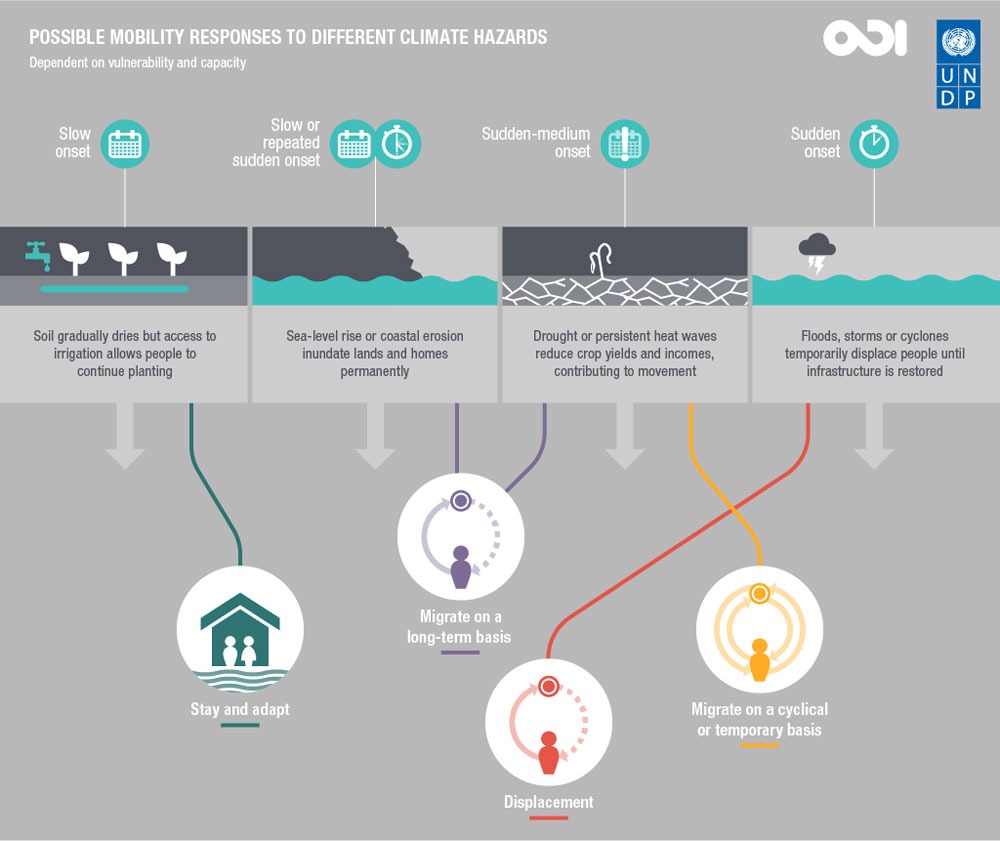
December 2, 2019; Common Dreams
As world leaders gather in Madrid for the United Nations’ 25th annual conference on climate change, Jack Johnson reports for Common Dreams that the nonprofit Oxfam International has released a new report, “showing that climate-related disasters were the leading cause of internal displacement over the past decade, forcing an average of over 20 million people to flee their homes per year.”
Titled Forced from Home, the 14-page report indicates that in many countries, climate refugees are not a future possibility, but a present-day reality. “Today,” it says, “you are seven times more likely to be internally displaced by cyclones, floods, and wildfires than by earthquakes and volcanic eruptions, and three times more likely than by conflict.” The report notes that these numbers represent a fivefold increase from the preceding decade.
The writers elaborate, “On average, over 20 million people a year were internally displaced by extreme weather disasters over the last 10 years—87 percent of all people internally displaced by disasters during this period. Millions more have been driven from their homes by drought, rising sea levels, and other ‘slow-onset’ climate-fueled disasters. More still are forced to flee across borders to find refuge outside their home country.”
Not surprisingly, climate change’s impact has fallen very unevenly, with low-income nations of the “Global South” suffering the most. As the report details:
Sign up for our free newsletters
Subscribe to NPQ's newsletters to have our top stories delivered directly to your inbox.
By signing up, you agree to our privacy policy and terms of use, and to receive messages from NPQ and our partners.
- “In Cuba, Dominica and Tuvalu, nearly five percent of the population has been displaced annually by extreme weather on average over this period—equivalent to almost half the of the population of Madrid being displaced within Spain in a single year.”
- “People in low- and lower-middle income countries such as Somalia and India are over four times more likely to be displaced by extreme weather disasters than people in high-income countries such as Spain and the United States.”
- “Many poor countries face multiple risks, with large numbers of people displaced by conflict as well as the climate crisis. In 2018 Ethiopia, Somalia, South Sudan and Sudan saw 3.8 million people newly displaced by conflict and just under one million people newly displaced by extreme weather disasters such as floods. These countries also regularly see large proportions of their population impacted by drought.”
All told, the report finds climate-related displacement risk is highest in the following ten nations: Cuba, Dominican Republic, Tuvalu, Philippines, Saint Maarten, Vanuatu, Fiji, Sri Lanka, Tonga, and Somalia—none of which are high carbon-emitting countries. (The Dominican Republic, at 96th among 193 UN member states, rates highest among the ten in per-capita carbon emissions.)
Meanwhile, according to the nonprofit consortium Climate Action Tracker, even with current carbon emissions reduction policies, the world is on a path to see a 3 degree Celsius global temperature rise by 2100, far above the UN target level of 1.5 degrees Celsius.
In response, Oxfam proposes that an international “Loss and Damage” fund be launched to assist displaced people and communities:
This facility should provide an assessment of global financing needs, clear criteria for disbursing funds and agreement on new and innovative ways of mobilizing additional funds, such as through a “climate damages tax” on fossil fuel extraction, as well as debt relief in the event of disasters.
In its report, Oxfam also calls on representatives at the UN gathering to follow through on a past commitment to create a $100 billion fund by 2020 to support reduced carbon emissions in poor countries, and advocates “a swift and just phase-out of fossil fuels” to bring the UN target global heating target level of 1.5 degrees Celsius back within reach.—Steve Dubb













